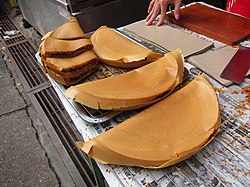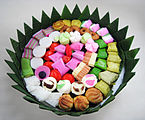Apam balik
 A giant apam balik in Malaysia. | |
| Alternative names | Ban Jian Kuih (Tâi-lô: bàn-tsian-kué), Chin Loong Pau, Min Chiang Kueh, Martabak Manis, Terang Bulan, Martabak Bangka, Kue Bandung, Apam Pulau Pinang, Kuih Haji, Kuih Malaya |
|---|---|
| Type | Pancakes |
| Place of origin | Fujian, China[1][2] |
| Region or state | Southeast Asia, Southeast provinces of China, Taiwan |
| Associated national cuisine | Brunei, Indonesia, Malaysia, Singapore |
| Main ingredients | Flour, hot water, baking powder, bicarbonate soda, sugar, eggs, peanut, margarine, butter |
Apam balik (lit. 'turnover pancake'),[3] also known as terang bulan (lit. 'bright moon'), martabak manis (lit. 'sweet martabak') or mànjiānguǒ (Chinese: 曼煎粿), is a dessert common in many varieties at specialist roadside stalls throughout Brunei, Indonesia, Malaysia and Singapore.[4]
Mànjiān (曼煎) is a homophone of Mǎnqīng (滿清), which ruled the final imperial dynasty in China, while guǒ (粿) means pancake.[5]
Origins[]
It is believed that the invention apam balik is related to General Tso, who was a Chinese statesman and military leader of the late Qing dynasty.[6] In 1855, the army of the Taiping Heavenly Kingdom invaded the Fujian region and General Tso was appointed to lead an army to crush the rebels. To provide the soldiers with food without interfering the life of local people, General Tso decided to switch from the flatbread which was eaten together with spring onion and chilli sauce, to the pancake that used locally-sourced and mass-produced ground cane sugar and peanut as filling. The recipe for the pancake was spread throughout the Fujian region, especially in places around Quanzhou and later on throughout the whole Southeast China. It was also brought into countries in Southeast Asia by the Chinese Hokkien immigrants.[1]
Other names[]
The dessert is also known by various names in different languages, depending on the region.
Indonesia[]

- Terang bulan,[7] (lit. 'bright moon') refer to the big round pancake, prior to folding, resembling the shape of a full moon, (in most of Indonesia)[8]
- Martabak manis,[7] lit. 'sweet martabak' (in Jakarta, West Java, Banten and the surrounding areas of southern Sumatra; South Sumatra and Lampung);
- Kue Bandung (in Semarang, Central Java and its surrounding areas[citation needed])
- Martabak bangka (in Medan, North Sumatra and its surrounding areas)
- Apam pinang (in West Kalimantan, East Kalimantan and North Kalimantan)
- Hok Lo Pan 福佬粄 (in Bangka, Belitung and Batam);[7]
Malaysia and Singapore[]
- Ban Jian Kueh (Tâi-lô: bàn-tsian-kué) (Hokkien)
- Min Chiang Kueh (Mandarin, in Johor and Singapore)
- Dai Gau Min (大塊麵) (Cantonese, in Perak)
- Chin Loong Pau (煎弄包) (Cantonese, in Kuala Lumpur/Selangor)
- Kap Piang 合餅 (Hakka, in Sabah)
- Mak Pan 麥粄 (Hakka, in general)[9]
- Apam Pulau Pinang (Malay, in Penang)[3]
- Kuih Haji (Malay, in certain areas)
- Apam Balik (Malay, in certain areas)
- Apong (Kelantan)
- Peanut Pancake (Singapore)
Brunei[]
- Kuih Malaya (Malay, in Brunei), named after the place where it came from when it was still known as Malaya.
Hong Kong[]
- 冷糕 (Cantonese)
- 砂糖夾餅 (Cantonese)
Taiwan[]
- 曼煎粿 (Hokkien)
- 麥仔煎 (Hokkien)
Description[]
The pancake's batter is made from a mixture of flour, eggs, sugar, baking soda, coconut milk and water.[7] The batter is cooked upon a thick round iron frying pan in plenty of palm margarine to avoid it sticking to the pan. Then other ingredients are sprinkled as filling; the most common or traditional is crushed peanut granules with sugar and sweetcorn kernels (available from cans), but modern innovations such as chocolate sprinkles and cheddar cheese are also available.[7] Then, the pancake is folded (hence the name: "turnover pancake") and cut into several pieces.[10]
In Indonesia there is a smaller version made with smaller pan, they are called martabak mini or terang bulan mini.
The texture of the apam balik can vary depending on the amount of batter and type of pan used, from one that is akin to a crispier form of crumpets to small thin light pancake shells that break when bitten (the latter is usually called apam balik nipis, 'thin apam balik').
There is a Peranakan variant, the apom balik, that closely resembles the Indonesian Serabi.

Martabak Bangka or Terang Bulan

Sweet Martabak filled with chocolate
Hoklopan

Martabak mini

Apam balik
See also[]
- List of pancakes
- List of stuffed dishes
- Peranakan cuisine
- Dosai
References[]
- ^ Jump up to: a b "傳統小吃滿煎糕的由來" (in Chinese). renminbao.info. Archived from the original on 20 December 2014. Retrieved 17 April 2021.
- ^ "每日一識-板煎嗲 @ 午間食客 C'est Qiutian :: 痞客邦 ::".
- ^ Jump up to: a b "Deliciously Unique Pancakes..." The Malaysia Pancake Co. Archived from the original on 1 June 2013. Retrieved 18 August 2013.
- ^ Malaysia, Singapore & Brunei. Lonely Planet. 2010. pp. 119–. ISBN 978-1-74104-887-2. Retrieved 18 August 2013.
- ^ https://web.archive.org/web/20141213155747/http://mag.sinchew-i.com/scgc/content.phtml?vol=20070826&sec=A75
- ^ Hummel, Arthur W. Sr., ed. (1943). . Eminent Chinese of the Ch'ing Period. United States Government Printing Office.
- ^ Jump up to: a b c d e "Martabak Manis Alias Kue Terang Bulan". Femina (in Indonesian). Retrieved 16 May 2015.
- ^ "r/MapPorn - Map of Nusantara divided by how they call a pancake-like street snack". reddit. Retrieved 29 February 2020.
- ^ "閩客語典藏::客英大辭典查詢結果".
- ^ Rondoletto. "Indonesian Sweet Martabak / Terang Bulan". Food.com.
External links[]
- Pancakes
- Bruneian cuisine
- Indonesian breads
- Indonesian desserts
- Indonesian pancakes
- Indonesian snack foods
- Malaysian breads
- Stuffed dishes






